Famous Monet Paintings – Top Claude Monet Artworks
In this article, we will share Claude Monet’s most famous paintings. This artist is known for being a part of the movement Impressionism – its name was originally inspired by the artwork Impression, Sunrise which is a very famous Monet painting. We will follow the artist’s career chronologically, giving you a brief description of fifteen of his best artworks.
Artist Abstract: Who Was Claude Monet?
Claude Monet was born Oscar-Claude Monet on 14 November 1840 in Paris and passed away on 5 December 1926. His father expected him to take over the family grocery store, but Monet wanted to be an artist instead. He studied at the Havre secondary school of the arts and established himself as a charcoal caricature artist in Paris.
After becoming the mentee of Eugène Boudin, Monet started practicing oil painting.
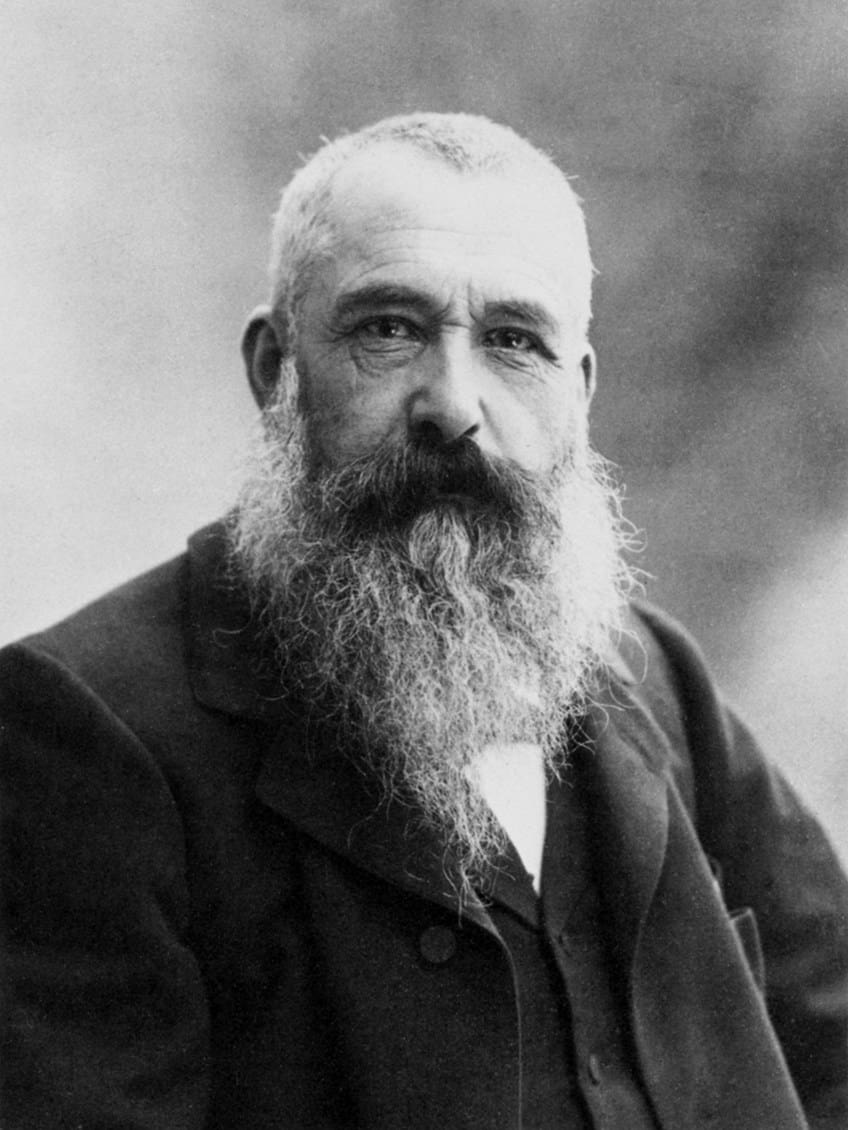 Portrait of Claude Monet by the photographer Nadar in 1899; Nadar, Public domain, via Wikimedia Commons
Portrait of Claude Monet by the photographer Nadar in 1899; Nadar, Public domain, via Wikimedia Commons
He became known as the originator of the French impressionist painting movement. He was the most committed to the movement’s philosophies and practices and reach fame later in his life because of this consistency. He specifically applied the Impressionist framework to Plein-air landscape painting.
Famous Monet Paintings
Monet created multiple well-known paintings throughout his career. He reached fame towards the end of his life with the successful series of paintings he did, which included the Haystacks, Waterloo Bridge, House of Parliament, Water Lilies series, and more. In this section, we will look at some of his most famous artworks.
Women in the Garden (1866)
| Date | 1866 |
| Medium | Oil on canvas |
| Dimensions (cm) | 255 × 205 |
| Art Movement | Impressionism |
| Location | Musée d’Orsay, France |
Women in the Garden shows a scene of four people relaxing and enjoying the sunlight in a garden. On the right of the composition, a woman is walking away from the viewer deeper into the garden. Her dress is swinging out around her feet, which creates the effect that she is running and paying. In the foreground, a woman is sitting on the grass, holding a bouquet of flowers. While the third woman is standing behind her to the right of the composition talking to a man that is sniffing a bouquet of flowers.
When Monet finished this painting, he submitted it to the Salon of 1876. It was refused on the bases that it had no clear narrative or subject.
The visible brushstrokes were also seen as sloppy and unfinished. Women in the Garden is so big that the artist had to install a special pulley system in the house he rented, while he was painting it, to be able to paint the top parts of this artwork. The painting depicts the garden of the house he rented in Paris.

In this Monet artwork, the artist explored how to paint figures in a landscape so that it looked as if air and light are moving around them. He achieved this in the way he painted the shadows with light filtering through the trees and plants, as well as the purposeful use of color in his depiction of light. Even though he painted figures, none of them have emotive facial expressions. They almost look like their expressions are blank, which confirms that the figures are only in service of the artist’s light rendering experiments.
They are not portraits of anyone specific. His wife modeled for all three of the female figures.
Impression, Sunrise (1872)
| Date | 1872 |
| Medium | Oil on canvas |
| Dimensions (cm) | 48 x 63 |
| Art Movement | Impressionism |
| Location | Musée Marmottan Monet, Paris, France |
Impression, Sunrise is one of Monet’s most famous paintings. It shows a sunrise over the Le Havre port. In the French harbor in this Monet painting, the mist creates a murky background. He created bright yellow and orange shapes in the sky and the reflection on the water. These warm colors contrast with the dark boats.
The movement of the water in the foreground makes it appear as if the smaller boats are being pushed by the current.
This motion element is created by the Impressionist brushstrokes that are short, vibrant, and put separate colors next to one another. Very little detail is painted in this Monet artwork. Claude Monet truly painted the scene aligned with Impressionism’s values – all of the colors and smudges rendered an impression of a sunrise.
Monet and several other artists that were rejected from the Parisian Salon exhibited together in April and May 1874. Amongst this group of over 30 artists, which would form the Impressionists after this exhibition, were Paul Cézanne, Edgar Degas, and Édouard Manet. The artworks in this exhibition were met with shock, with some viewers even describing them as graffiti. Claude Monet’s Impression, Sunrise drew the most attention. The viewers of this exhibition claimed to not be able to recognize what the painting was depicting at all.

The critic M. Louis Leroy famously wrote an article referring to the work as “Impressionist” – referencing the title of this famous Monet painting. Even though Leroy used this description of Monet’s painting mockingly, the group of artists happily decided to use it as the name for their style and art movement.
Although this painting inspired the name of the Impressionist art movement, it is the least Impressionist work by Monet.
The light treatment and color are not typical of Impressionism as they are very restrained. Monet applied the paint in a discontinuous manner with contrasting colors painted in thin washes instead of the more impasto style characteristic of Impressionism. Instead of packing the canvas full of vibrant color – like later in his career – Monet left some areas of this canvas exposed.
The Poppy Field Near Argenteuil (1875)
| Date | 1875 |
| Medium | Oil on canvas |
| Dimensions (cm) | 54 x 74 |
| Art Movement | Impressionism |
| Location | Musée d’Orsay, Paris. Paris, France |
The painting depicts a summer day with a beautiful expansive blue sky above a field of poppies. There are two pairs present in the scene: a mother and a child in the foreground and the background. We can deduce that the mother and child in the foreground are his wife, Camille, and Jean, their son. His family often modeled for Monet’s art.
During the time Claude Monet painted The Poppy Field, he was very stimulated by the scenery around him.
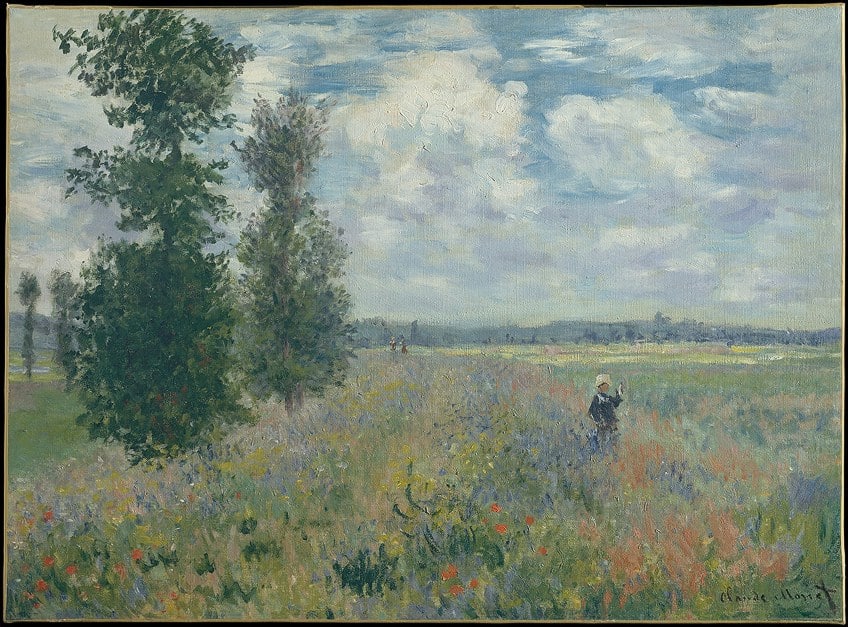
His en Plein air painting was developing even though his wife Camille was struggling with her health and his art dealer, Paul Durand-Ruel, had to help the artist support his family. The Poppy Field was also exhibited at the 1874 Impressionist exhibition, the first show by the group.
The bright blue sky and vibrant poppy field create a separation in color fields with a dominant blue-green area and a red color plane.
The figures in the painting – a mother and child in the foreground and another pair in the background – simply support the structure of the composition. The two pairs create a triangle composition with a big tree just off-center towards the right of the painting. This adds a balanced feeling to the scene and asserts the essence of tranquility.
Woman With a Parasol (1875)
| Date | 1875 |
| Medium | Oil paint |
| Dimensions (cm) | 100 x 82 |
| Art Movement | Impressionism |
| Location | National Gallery of Art, Washington, D.C., United States |
The scene in Woman With a Parasol is set outdoors, where Monet painted it most likely in one lengthy session. The female figure in the foreground takes up most of the compositional space, with the child in the background and the parasol in the woman’s hand completing the triangular composition.
A vibrant scene of flowers and grass at the woman’s feet compliments the movement of the clouds in the sky.
In the first section of Monet’s career, we could see figures included in his landscapes. He, however, moved away from this in the late 1860s and 1870s to focus on developing his landscapes for a few years. In the late 1870s and during the 1880s, he returned to this subject. Woman with a Parasol is one of the first of these paintings.
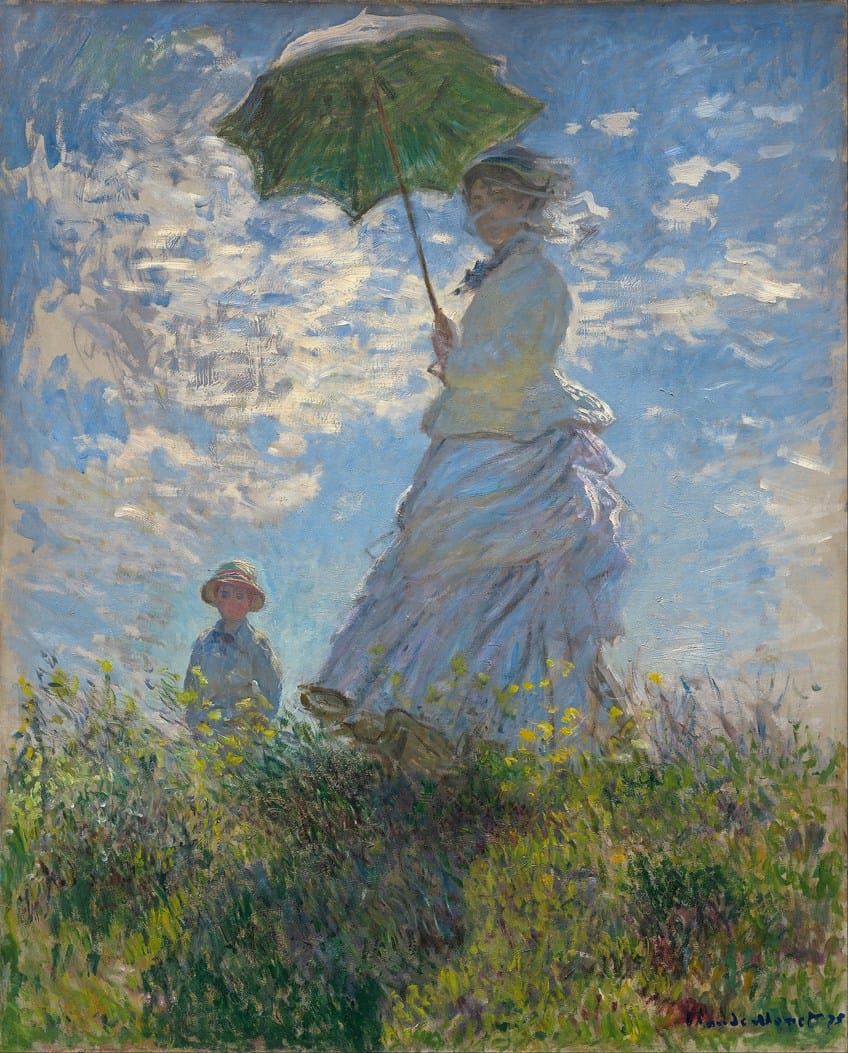
Monet wanted this painting to show a relaxed family excretion instead of a serious portrait. He asked his first wife, Camille, and their son, Jean to pose for him, making it look like they stopped mid-stroll to quickly look at him while he captured them on their way. The viewpoint in this painting is uncommonly low for a Monet artwork. Camille looks monumental like she is an icon in the painting.
Her dress brings a sense of movement in the painting, while the rest of the figures look quite frozen. It is as if Monet captured a rare and fleeting moment in time.
La Japonaise (1876)
| Date | 1876 |
| Medium | Oil on canvas |
| Dimensions (cm) | 231.8 × 142.3 |
| Art Movement | Impressionism |
| Location | Museum of Fine Arts, Boston, United States of America |
In La Japonaise, Camille poses in a blond wig and one of Monet’s Japanese theatre costumes – a magnificent robe with a samurai printed on it. She is holding a fan in her hand and is turning around to look over her shoulder to the viewer. Behind her, there is a wall hung with beautiful patterned Japanese fans and a few are scattered on the floor by the woman’s feet.
The painting was exhibited in the second Impressionist Exhibition and received very good feedback. This Monet painting marks a very sudden change in style.
At the time, Monet was struggling with money and critics speculate that he purposefully chose to paint a composition that was more conventional to sell the painting quickly. This is also evident in the lack of spontaneous and feathery brushstrokes the artists used in the previous decade of painting.
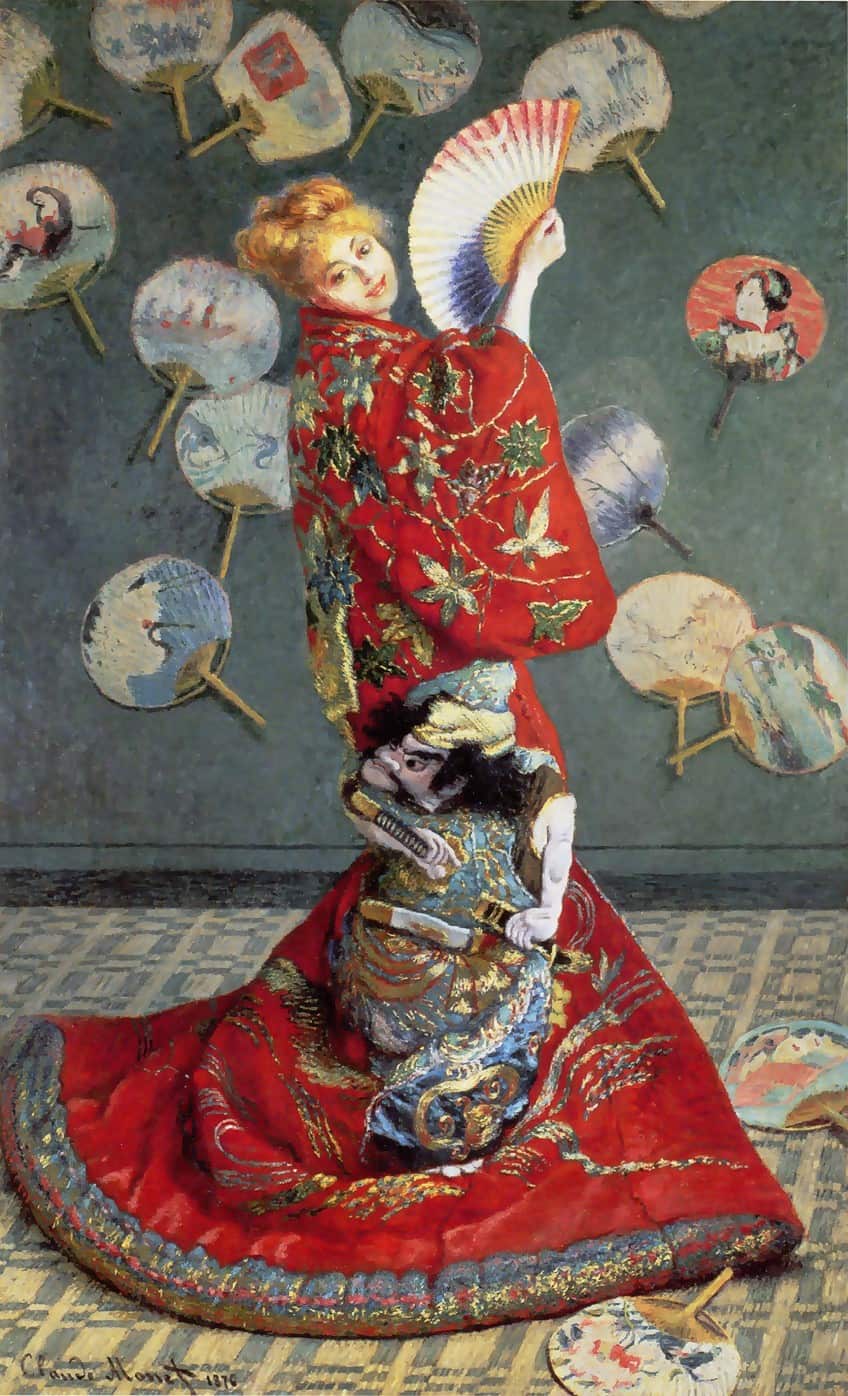
During the 1860s and 1870s, there was a big following of Japanese art in Europe. Most avant-garde artists were influenced by Japanese prints, and so was Monet. Monet was one of the first collectors of the colorful woodcut prints and Japanese costumes that started spreading throughout the West from 1854 on. In La Japonaise, Monet abruptly moved over to flat and dense areas of color, applying the paint in thick impasto.
The painting depicts the performance of Japanese culture instead of its authentic expression. This motion is driven home by the blond wig, as it emphasizes the model’s European origin.
Stormy Sea in Étretat (1883)
| Date | 1883 |
| Medium | Oil on canvas |
| Dimensions (cm) | 100 x 81 |
| Art Movement | Impressionism |
| Location | Musée des Beaux-Arts de Lyon, Lyon, France |
The Stormy Sea in Étretat shows a wild sea during a typical winter’s day. He painted the cliff Seine-Maritime in the background of the painting. In the foreground, a beach with three small boats filled with thatch can be seen. To the right of the beach, there is a broken boat with two fishermen standing around it.
In Normandy, there was a region called Caux that inspired Monet a lot at this time of his career – specifically a place called Étretat.

He frequently visited it from 1883 to 1886. He experienced it as having beautiful scenery and he produced over 50 paintings of it during the return visits. He started and finished Stormy Sea in Étretat at the hotel he stayed at. In typical Impressionist style, he created vibrant movement by using individual brush marks, incorporated with rich colors. Monet is famous for adding one color over another color while it is still wet.
This resulted in color combinations that are not fully mixed. This technique is apparent in this painting and gives it an energetic quality.
Portrait of Poly (1886)
| Date | 1886 |
| Medium | Oil on canvas |
| Dimensions (cm) | 64.5 × 52.1 |
| Art Movement | Impressionism |
| Location | Musée Marmottan Monet, Paris, France |
Portrait of Poly shows a man in a hat with a wild beard sitting on a chair. Poly is looking at the viewer with only his eyes – the rest of his face and body slightly turned away to the left of the composition. His nose is round and his face has a reddish tone.
Monet was staying and working in Belle-Ile for a while. While he was there, a fisherman named Guillaume Poly came to the inn he stayed at often.

His features and interesting face attracted Monet’s attention. Even though Monet started his career as a caricaturist in Paris, he did not often paint portraits like the Portrait of Poly when he was an established artist. Monet’s earlier experience and interest in painting faces is evident in this famous Monet painting as it is filled with character.
The focus is completely on Poly, as the background is left vacant. The energetic brushstrokes seem to convey the inner landscape of this character. His hat and beard signify more of his character.
Wheatstacks (End of Summer) (1890)
| Date | 1890-1891 |
| Medium | Oil on canvas |
| Dimensions (cm) | 60 × 100 |
| Series | Haystacks |
| Art Movement | Impressionism |
| Location | Art Institute of Chicago, United States of America |
Wheatstacks (End of Summer) or Les Meules à Giverny is part of another Plein air series by Claude Monet titled Haystacks as well. Each of these Monet paintings has a similar composition painted at different times of the day. Wheatstacks (End of Summer) shows two of the 15- to 20-foot haystacks that were outside Monet’s house at Giverny.
The series of artworks titled Haystacks are among the famous Monet paintings that are intrinsically associated with the Impressionist movement.

These 25 studies of haystacks were created near his Giverny house. He started many of the studies of the haystacks outside but understood quickly that he had to finish them inside his studio because the light changed so fast. Monet wanted to experiment with how light, shadow, and weather conditions would influence the same subject. In Wheatstacks (End of Summer), the haystacks break the horizon, towering out from the field almost as if they are animate.
The artist famously accounted that the haystacks were a symbol of nourishment and survival to him.
Poplars at Giverny, Sunrise (1891)
| Date | 1891 |
| Medium | Oil on canvas |
| Dimensions (cm) | 72 x 90 |
| Series | Poplars at Giverny |
| Art Movement | Impressionism |
| Location | National Museum of Western Art, Tokyo, Japan |
In Poplars at Giverny, Sunrise, we see an almost deconstructed scene of Poplars trees on the bank of a river. The early morning light, motion of the trees, or just the artist’s Impressionist style renders the trees in small spotted brush strokes creating a lively composition. The Epte river near Monet’s house in Giverny was bordered by Poplar trees. This was one of the artist’s favorite subjects for a while and he painted 24 paintings of this scene in his life.
He started this series after he finished the famous Monet painting series, Haystacks.
While Monet was busy painting the Poplars, the governing party of Limetz put them up for sale. Monet, however, negotiated with the buyer who wanted to cut them off. He convinced the new owner to delay his plan for the trees, so Monet could finish painting them in autumn as well. Monet painted the trees by rowing a small boat with a special place for canvases close to the trees.
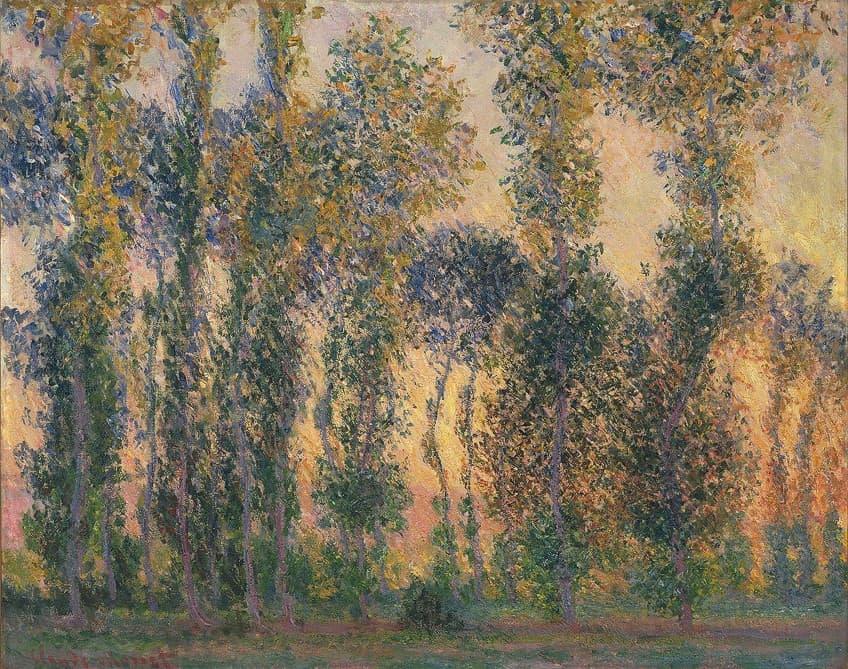
As with his famous and successful Haystack series, Monet painted Poplars at Giverny, Sunrise to further his study on the nuanced effect of light and seasons changing on a landscape. In all of these paintings as in Poplars at Giverny, Sunrise, Monet paints the composition in an embellishing style and bright colors.
This seems to depict the reality of the landscape as well as the artist’s idea of the scene – producing a dreamlike scene.
The Water Lily Pond (1899)
| Date | 1899 |
| Medium | Oil on canvas |
| Dimensions (cm) | 93 x 74 |
| Art Movement | Impressionism |
| Series | Water Lilies |
| Location | Metropolitan Museum of Art New York, United States of America; The National Gallery, London, United Kingdom |
The canvases of the Water Lily Pond series are famous Monet paintings today. The specific work mentioned here (from the year 1899) is special because of its remarkable composition that shows trees in the background including willow trees and his bridge over the artist’s famous lily ponds. Monet struggled financially throughout his life, but in the 1890s this came to an end. He bought the house at Giverny with money he had saved and was also able to invest in the garden and make his house beautiful.
The garden became very beautiful and special – with Monet spending a lot of time getting his beloved lily ponds in the perfect state.
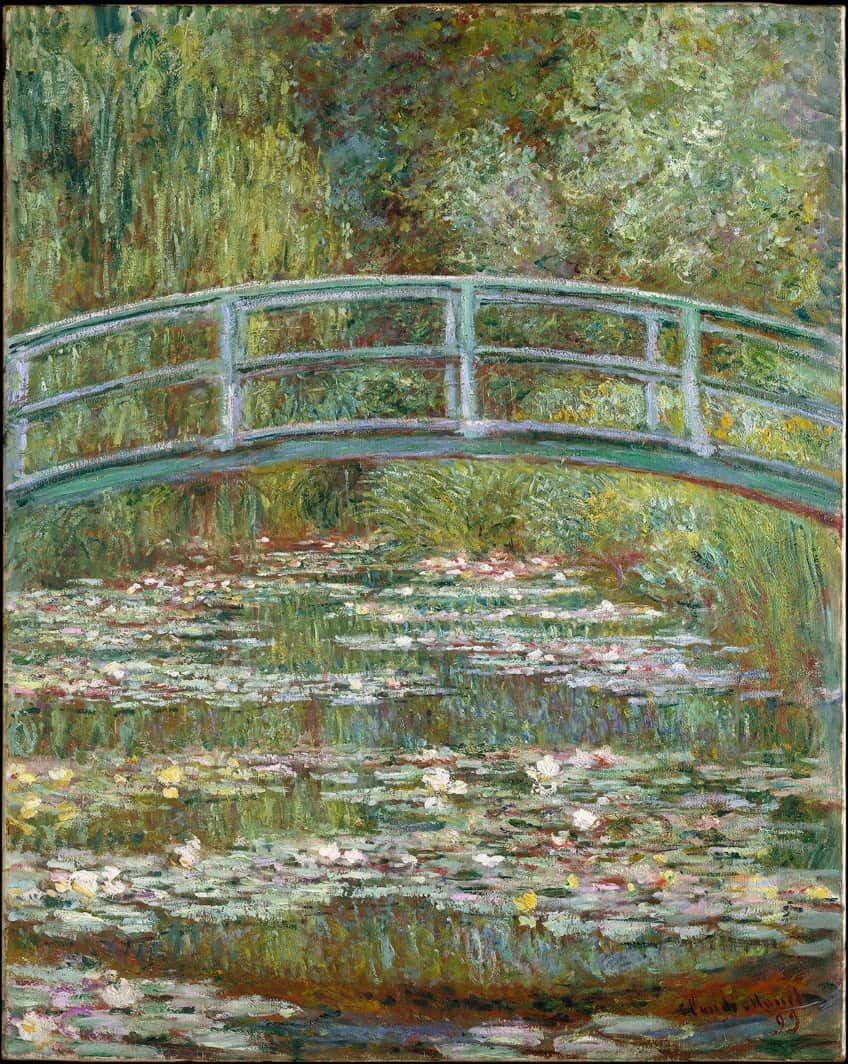
At the beginning of this project, he did not plan to paint them but completely fell in love with the subject as he created his dream garden. After he got permission in 1893 to build the bridge, he started including this famous element in his paintings as well. In this Monet artwork, the pond is bursting with lilies and water plants. He painted the scene with short and energetic brushstrokes characteristic of his adult life. This canvas is significantly smaller than the later painting Monet made on the same subject.
When the Water Lily Pond paintings were exhibited for the first time at Durand – Ruel’s gallery critics noted that the influence of Japanese art is very apparent in them.
The dense green of the pond, enclosed and highlighted by the bridge at the top also reminiscent of the Medieval images of the enclosed garden. These elements give the scene a meditative effect, inviting the viewer to linger and reflect.
The Artist’s Garden at Giverny (1900)
| Date | 1900 |
| Medium | Oil on canvas |
| Dimensions (cm) | 81,6 × 92 |
| Art Movement | Impressionism |
| Location | Musée d’Orsay, Paris, France |
In The Artists Garden at Giverny, we see Claude Monet’s garden at Giverny. Here, Monet painted one of his favorite subjects: the purple Iris flower. He was not the only impressionist that like to paint this flower – Van Gogh also famously captured this vibrant flower on his canvas. It is well known that Monet loved gardening and had a lot of knowledge about this leisure activity. He spent a lot of time planning the layout and aesthetic effect of specific flowers blooming together.
He gardened with the end result’s colors and textures in mind. He, of course, spent just as much time painting his garden.
Giverny was this artist’s last home before he passed away and he lived there for the longest time. There he explored his gardening skills and made his gardening dreams come true. The garden he created there was magnificent and included his famous ponds. The most famous Monet paintings are of his lily ponds in this garden. However, different parts of this garden were also an inspiration for Monet’s art.

Let’s compare Van Gogh and Monet in their rendering of the iris flower. We can see how differently the rules of Impressionism were interpreted by them: Van Gogh created vibrant colors for the flower petals and for the blue leave and red ground. The canvas comes alive in swirling colors, while the Irises in Monet’s artwork are a glorious scene. They are painted under the willow trees of his garden. The sunlight is patchy and throws shade in some areas of the picture. But there where it hits the Irises, the flower petals are shining in the sunshine and seem to float above the clumps of stems and leaves.
This Monet painting shows how he tried to reactive the sunshine’s glowing effect by using a color palette of bright colors.
The Houses of Parliament, Sunset (1903)
| Date | 1903 |
| Medium | Oil on canvas |
| Dimensions (cm) | 81 x 92 |
| Series | The Houses of Parliament |
| Art Movement | Impressionism |
| Location | National Gallery of Art, Washington, D.C., United States of America |
In the painting Houses of Parliament, Monet shows the parliament building through the famous London fog on a cold day, probably during fall or winter. The sun is setting behind the big structure, reflecting beautifully on the river Thames in the foreground. Monet loved painting the Parliament building in London on the side of the Thames River during the early 1900s. It became a common theme in his artworks of this time.
He created most of the paintings in this series from the terrace of St. Thomas’s Hospital. The hospital was on the other side of the Thames River.

During this time when Monet painted a body of work called the Late London series, which included scenes of the Charing Cross Bridge, Waterloo Bridge, and the Houses of Parliament, he was no longer doing purely Plein air painting. He continued to work on all these paintings when he returned to France and used photographs as references. This change of method evoked upset responses from the art world but Monet was not bothered by it – stating that the way he created his artworks was up to him.
The mist in The Houses of Parliament, Sunset makes the scene look supernatural, almost eerie. The foggy effect of the light creates the feeling that the building is ominously waiting or observing the city.
It seems to float in the air, as the only suggestion of the river is the reflection of the light on the water. The sky and the water are painted with bright expressions of orange and purple, strikingly contrasting with the dark shape of the buildings and shadows.
Waterloo Bridge (1903)
| Date | 1903 |
| Medium | Oil on canvas |
| Dimensions (cm) | 68 x 101 |
| Art Movement | Impressionism |
| Series | Waterloo Bridge |
| Location | National Museum of Western Art, Tokyo, Japan |
Waterloo Bridge was painted in the same period of Monet’s career as the above-mentioned painting of The Houses of Parliament. In it, we can see Waterloo Bridge, with London in the background. The scene is so foggy that it appears as if a part of the bridge is disintegrating. In the foreground, there is a boat in the water.
As with The Houses of Parliament series, Monet was fascinated by the fog in London in the Waterloo Bridge renderings.
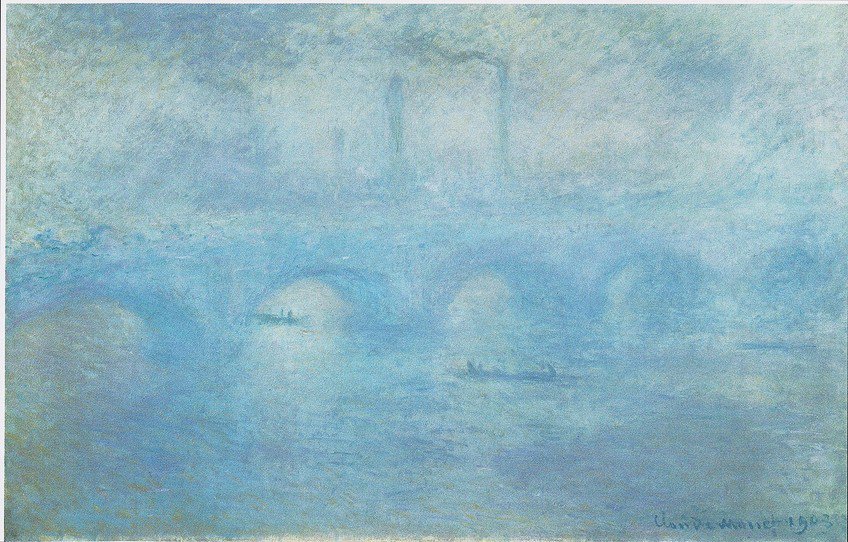
The effect the mist had on the light and reflection on the river Thames, kept him coming back to this subject for further exploration. He painted the scene in this Waterloo Bridge painting from his hotel room on the fifth floor of the Savoy hotel.
Monet painted the city in a very different palette from his contemporaries.
Instead of using the usual grim and gray color scheme, he used bright colors that shone through the misty and smokey scenes. In the painting, we can see how he used hues of violet and pink to portray the effect of the sun through the city’s smog. He painted the sky in pale green.
Water Lilies, Sunset (1914)
| Date | 1914 |
| Medium | Oil on canvas |
| Dimensions (cm) | 200 x 600 |
| Series | Grandes Decorations |
| Art Movement | Impressionism |
| Location | Musée d’Orsay, Paris, France |
In Water Lilies, Sunset, Monet’s beloved lily ponds are shown in a swirl of early morning yellows, pinks, and greens. His composition is completely focused on the water of the pond, with the borders not visible. The water, plants, and reflection look nearly indistinguishable in a stunning composition.
Monet’s second wife, Alice, passed away in 1911. After her death, Monet returned to painting the water lily pond outside his house.
When he returned to this subject he changed his strategy a bit, the most notable change was the scale of the canvases he chose to paint. He also used a slightly different palette by adding bright dots of color for the flowers. These massive paintings that seem to devour the viewer into the artist’s world are the most famous Monet paintings and are visited by thousands of art enthusiasts every year. Monet stayed true to his Impressionist roots until the end.
As evident in this painting, Water Lilies, Sunset, he continued later in his life to capture the effect of light and reflect on his beloved pond.
Water Lilies (1916)
| Date | 1916 |
| Medium | Oil on canvas |
| Dimensions (cm) | 200.5 × 201 |
| Art Movement | Impressionism |
| Series | Grandes Decorations |
| Location | The National Museum of Western Art, Tokyo. Tokyo, Japan |
Water Lilies (1916) depicts the famous lily ponds of Monet’s garden at Giverny in striking purple, blue, and pink hues. Weeping willow branches are either hanging from the top of the composition into view or are reflected in the pond. The reflection of pink swirling clouds is also rendered in the mirror water of the pond, with pink water lilies blossoming in the foreground.
Due to the large scale of the paintings Monet created of the lily ponds, he had to have another studio built in 1915 – the third one on his property at Giverny.
He created the Water Lilies of 1916 there. He continued to paint the massive impressions of the pond even though the war was in full swing around him. Even when his son was serving in the war, he continued to create these immersive and meditative scenes.

Soon after he complete this canvas, Monet heard that he would have an opportunity to exhibit them supported by Minister Georges Clemenceau (1841-1929). He selected only 12 of the massive panels and called the series Grandes Decorations. For him to prepare for this exhibition, the State also bought the Monet painting Women in the Garden (1866).
This helped him cover the exhibition costs.
When this Water Lilies painting was created Monet was already struggling with his eyesight. The dark hues of green seem to contrast even more with the light hues of the lilies. His wispy brushstrokes are also more in this painting, making it seem more animated than some of the others in this series.
Claude Monet is one of the most prominent Impressionist painters. His enormous Water Lily Pond paintings still resonate with many art lovers around the world. In his life, he created multiple well-known artworks, with only 15 of them listed in this article. We hope this account of his career gave you a good overview of his life and work.
View our Famous Monet Paintings web story here.
Frequently Asked Questions
What Are Monet’s Most Famous Paintings?
Claude Monet (1840 – 1926) is most famous for creating a series of Water Lily Pond paintings between 1896 and 1920. These paintings vary in size, with the Grandes Decorations series being the most impressive in size and technique.
How Many Water Lily Pond Paintings Did Monet Create?
Claude Monet created approximately 250 paintings of the water lily ponds at his home in Giverny. After his second wife, Alice, died he started creating much bigger paintings on this subject than before. He also decided to let go of the frame behind the canvas so these paintings could be installed with a slight curve in them. This made them even more immersive and completely integrated into the artist’s and viewer’s surroundings.
Where Did the Name Impressionism Come From?
In April and May 1874, several artists – including Claude Monet – were rejected from the Parisian Salon exhibited together. The critic M. Louis Leroy famously wrote an article referring to Monet’s artwork Impression, Sunrise (1872), as being Impressionist. Even though Leroy used this description of Monet’s painting in a mocking way, the group of artists happily decided to use it as the name for their style and art movement.
Nicolene Burger, a South African multimedia artist and creative consultant, specializes in oil painting and performance art. She earned her BA in Visual Arts from Stellenbosch University in 2017. Nicolene’s artistic journey includes exhibitions in South Korea, participation in the 2019 ICA Live Art Workshop, and solo exhibitions. She is currently pursuing a practice-based master’s degree in theater and performance. Nicolene focuses on fostering sustainable creative practices and offers coaching sessions for fellow artists, emphasizing the profound communicative power of art for healing and connection. Nicolene writes blog posts on art history for artfilemagazine with a focus on famous artists and contemporary art.
Learn more about Nicolene Burger and about us.
Cite this Article
Nicolene, Burger, “Famous Monet Paintings – Top Claude Monet Artworks.” artfilemagazine – Your Online Art Source. January 3, 2023. URL: https://artfilemagazine.com/famous-monet-paintings/
Burger, N. (2023, 3 January). Famous Monet Paintings – Top Claude Monet Artworks. artfilemagazine – Your Online Art Source. https://artfilemagazine.com/famous-monet-paintings/
Burger, Nicolene. “Famous Monet Paintings – Top Claude Monet Artworks.” artfilemagazine – Your Online Art Source, January 3, 2023. https://artfilemagazine.com/famous-monet-paintings/.



